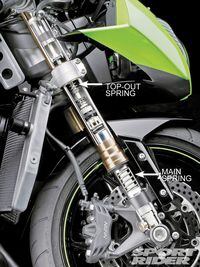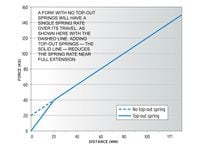I recently purchased a 2008 ZX-14. I had no problems getting the shock set up but when it came to adjusting the fork I was completely puzzled by the results I was getting. By running the adjusters through the extremes of adjustment my useable range of sag was between 42mm and 56mm. Typically, I set sag to 30mm front and rear. I have set sag on the numerous sportbikes I have owned over the past 26 years and have never encountered anything like this. I searched the Internet and the only real information I found was on Race Tech's site. The info leads me to believe I have encountered what's known as "top-out" springs. I have read the Race Tech tip "Sport Bike Relaxed Preload" but it is still unclear to me how I go about setting up fork sag properly on this bike. Race Tech says the bike has a long top-out spring and "this requires 20mm relaxed preload minimum". Does this mean I just deduct 20mm from my calculations to get the correct sag? I am not sure how to go about setting the fork sag on this particular bike, could you enlighten me?
Dan Forest
Goffstown, NH
Yes, the ZX-14 has long, soft top-out springs in the front fork, and that does make it difficult to set sag properly. Originally, top-out springs were intended to provide a soft buffer for the fork to fully extend against when - for example - the front wheel came off the ground. But over the last few years, other advantages have been found by using long, soft top-out springs in both the fork and shock. The chart shows how the overall spring rate in a fork is affected by the addition of a top-out spring. The rate near full extension changes as the top-out spring compresses, effectively working against the main spring's extension. The advantage can be seen here: with a conventional setup, it takes a significant amount of force (20kg in our example) to compress the fork at all. This means that as you accelerate out of a corner, if there is less than 40kg of weight on your front wheel (20kg on each fork tube) the suspension won't budge. This leads to the front end skipping over bumps and potentially causing headshake. A fork with long top-out springs will move with any force applied at all, making it much more compliant over small bumps accelerating out of corners.
Race Tech defines relaxed preload as how much the spring would be compressed when installed if the top-out spring were to remain fully extended. But the top-out spring compresses when the main spring is installed, meaning you would have to disassemble your fork to make these measurements and check. How the main spring and top-out spring interact depends on the rate of each, so there is no set rule to use when setting sag. You will certainly want more than 30mm to account for the top-out spring, but not necessarily 20mm more.
In these cases it's best to set sag based on how your bike handles. Put a zip tie on a fork tube to make sure the fork is not bottoming, and experiment with front preload settings to see how your bike reacts to the changes. Pay particular attention to its behavior exiting corners, as the other danger is that the fork will still top out under acceleration. Record your sag numbers as you go, so that if you start to make internal changes you'll have a baseline to work from. Note that your ZX-14 also has a top-out spring in the shock; the same concept applies to the rear shock under braking, when the rear wheel is skimming over the pavement. You may want to experiment with your rear sag setting as well.
Got a question?
The Geek
831 S. Douglas St.,
El Segundo, CA 90245
or e-mail srmail@sorc.com


/cloudfront-us-east-1.images.arcpublishing.com/octane/ITVHWHVQ75BQBHACERYDJLPLHE.jpg)
/cloudfront-us-east-1.images.arcpublishing.com/octane/M3QRBSQ4VFEVPKYTTM3OETVFBU.jpg)
/cloudfront-us-east-1.images.arcpublishing.com/octane/H3EMT5NJ5BDZPBBH27SW3ADQH4.jpg)
/cloudfront-us-east-1.images.arcpublishing.com/octane/XTROSHDZFJB5DIJYU2VF2REFIU.jpg)
/cloudfront-us-east-1.images.arcpublishing.com/octane/7EUSM4GQEBEFTPAYZ6MOMKMMUQ.jpg)
/cloudfront-us-east-1.images.arcpublishing.com/octane/ZN44KZLHD5CHVIY3WZYAGTPGSI.jpg)
/cloudfront-us-east-1.images.arcpublishing.com/octane/5A776WXBY5GAPDYFTTUEUZNIJA.jpg)
/cloudfront-us-east-1.images.arcpublishing.com/octane/NCYHFQ2S3BAT7EC7VDN2ONGRTU.jpg)
/cloudfront-us-east-1.images.arcpublishing.com/octane/XQORS527YFFT3MVI326EOEYJUI.jpg)
/cloudfront-us-east-1.images.arcpublishing.com/octane/TVDPP3TGMZHODFXASIFUM2KD34.jpg)
/cloudfront-us-east-1.images.arcpublishing.com/octane/EWDMR3DDTBBQPI7DQVZCLMRFAE.jpg)
/cloudfront-us-east-1.images.arcpublishing.com/octane/4XHHLVOUKFE3PDSWNSV4JJMGOE.jpg)
/cloudfront-us-east-1.images.arcpublishing.com/octane/5RLI3NQKQJA3LKKCQHRXQFTL6Q.jpg)
/cloudfront-us-east-1.images.arcpublishing.com/octane/3QCYJCI2RNBENIRWAKEOEKHFUM.jpg)
/cloudfront-us-east-1.images.arcpublishing.com/octane/XJFFFMRN6VEZ7CDNAGKWVPC3H4.jpg)
/cloudfront-us-east-1.images.arcpublishing.com/octane/RMC3CHWSHFAUJA2WJ2FVG4NBOA.jpg)
/cloudfront-us-east-1.images.arcpublishing.com/octane/WXEZV4WAYBERFKSRE5M7GQBW7A.jpg)
/cloudfront-us-east-1.images.arcpublishing.com/octane/LO3PZVGICFGJZBNUA2ORUSAUSE.jpg)
/cloudfront-us-east-1.images.arcpublishing.com/octane/UFHLTNOXLVARVLZV32M6ZJZV4Y.jpg)
/cloudfront-us-east-1.images.arcpublishing.com/octane/CTSWNU7SNNCC3LWB2KATYZ5AXY.jpg)
/cloudfront-us-east-1.images.arcpublishing.com/octane/72EPJVNA2VGVXJ2BVDFFLN67KQ.jpg)
/cloudfront-us-east-1.images.arcpublishing.com/octane/A7C4GNXEHNHC3LL6RETG6MIPPY.jpg)
/cloudfront-us-east-1.images.arcpublishing.com/octane/Q4KZ7ACKF5BVTE56LMG7RPJCEM.jpg)
/cloudfront-us-east-1.images.arcpublishing.com/octane/RQ2CXG6ATJBUZGUR7NP35C3VBE.jpg)